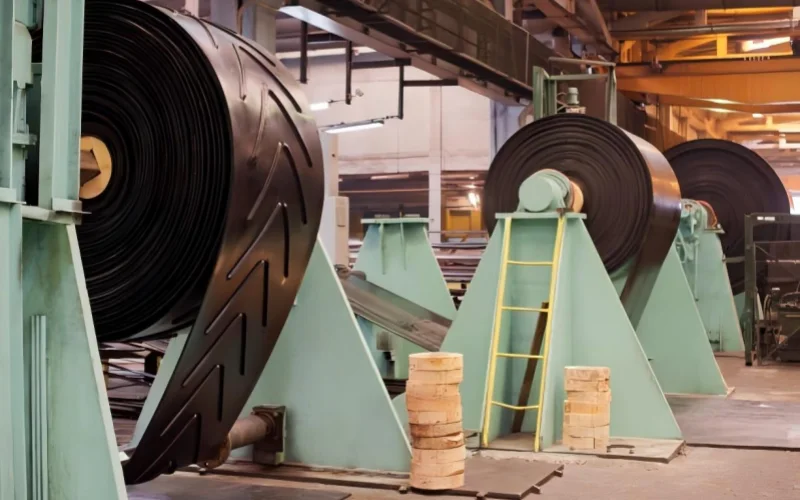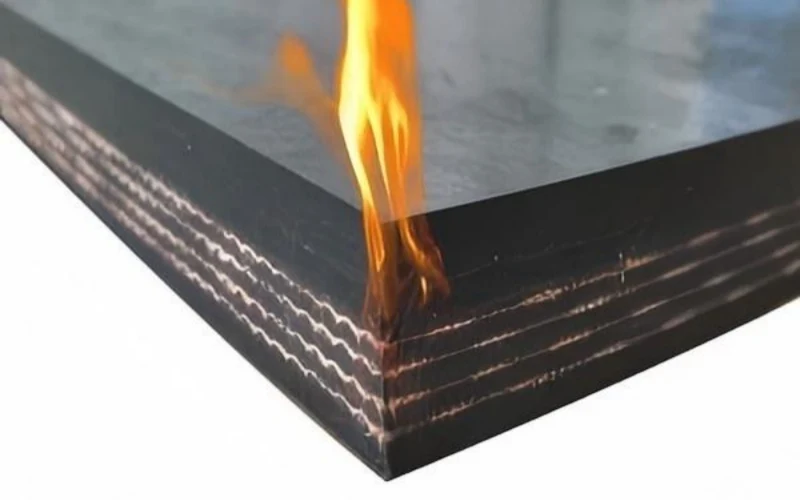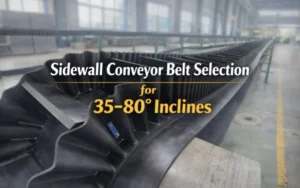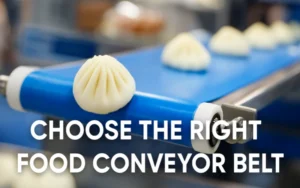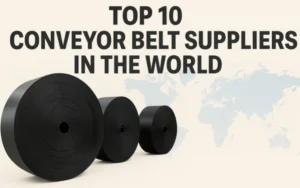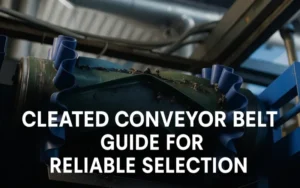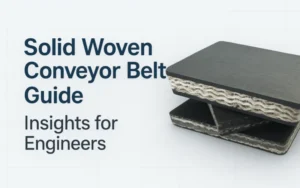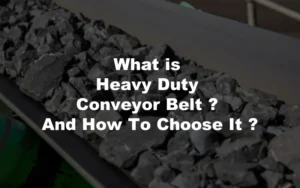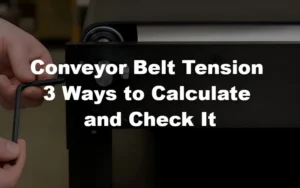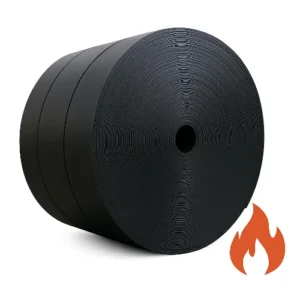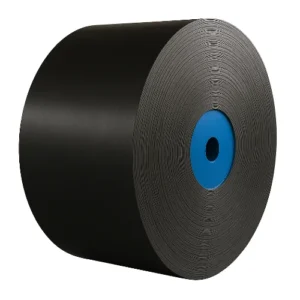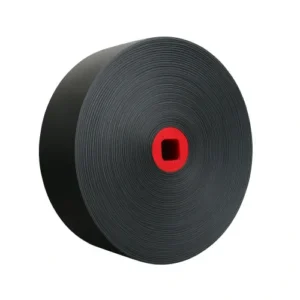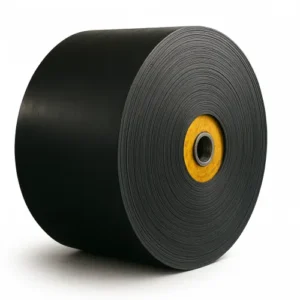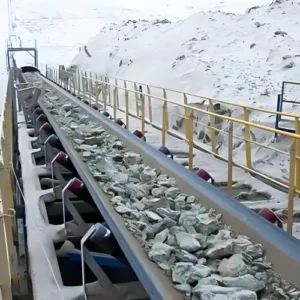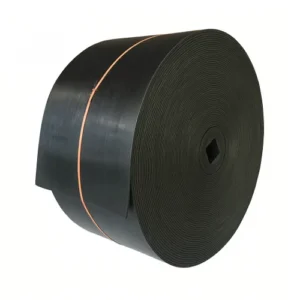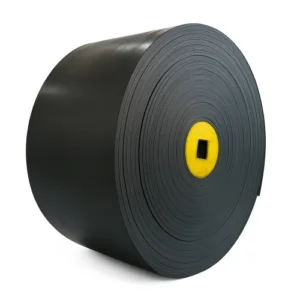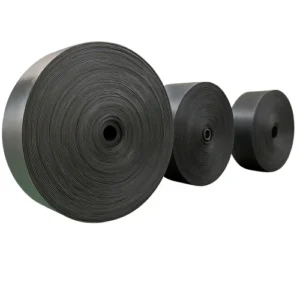1. Overview of Chevron Conveyor Belt
1.1 A Functional Design: What Chevron Conveyor Belts Actually Are
In the world of bulk material conveying, the flat belt may be your everyday sedan—but when the road turns uphill, you reach for something with grip. That’s where the chevron conveyor belt earns its place.
Engineered with angled cleats—usually shaped in V, U, or Y configurations—a chevron conveyor belt provides mechanical assistance where standard belts fall short. These raised profiles aren’t cosmetic; they’re a designed interface between material and belt, creating friction, pocketing loose particles, and resisting rollback on slopes.
What makes them function isn’t magic—it’s geometry. The cleats interrupt the natural flow of material, introducing micro-obstacles that counteract gravity. Think of it like controlled turbulence: enough resistance to stop slippage, but still allow movement.
This cleated structure allows the belt to function efficiently at inclination angles up to 40°, depending on the material type, moisture content, and particle size. In contrast, flat belts generally max out around 18°–20° before productivity takes a nosedive.
Chevron belts come in a wide range of configurations:
- Cleat heights: typically 5mm to 32mm
- Belt width: from 300mm up to 2400mm
- Material options: rubber for durability, PVC for flexibility, PU for specialized environments
- Pattern designs: open V for coarse aggregates, closed V or U for fine or sticky materials
It’s not just about moving things uphill—it’s about controlling them, precisely and consistently, under real-world conditions.

1.2 Where It Works—and What It Handles
The value of a chevron conveyor belt becomes evident in environments where gravity becomes a problem, and where the material itself refuses to cooperate.
Let’s break it down by industry:
Sector | Material Type | Conveying Challenge |
Mining | Wet coal, ore, damp gravel | Slippage and material fallback on steep grades |
Agriculture | Fertilizer, soybeans, corn | Spillage during inclined loading at field sites |
Recycling | Shredded plastics, broken glass | Material scatter and low-density instability |
Construction | Cement, sand, aggregates | Abrasion and material shift under vibration |
Now, real-world conveying isn’t clean or predictable. You may have to move damp limestone up a 28° incline in a quarry with zero room for a horizontal run. Or transport fertilizer across mobile equipment that vibrates, shifts, and changes angle constantly.
In these cases, chevron belts shine not because they are stronger—but because they’re engineered for frictional certainty. The cleat design transforms chaotic flow into controlled motion. It stabilizes what would otherwise be a high-maintenance, low-efficiency system.

1.3 The Real Advantage Over Flat Belts
Yes, chevron conveyor belts handle steeper inclines. But that’s only the first half of the story.
Their real power lies in how they change the operating dynamics of your entire conveying line. Here’s what that means in practice:
- Steeper Inclines, Less Infrastructure
With angle limits reaching 35°–40°, you cut down on conveyor length and frame height—translating to less steel, fewer pulleys, and smaller footprints. - Higher Throughput Without Oversizing
By minimizing rollback, these belts maximize net material flow, often boosting capacity by 15–30% without changing motor power or belt width. - Energy and Tension Efficiency
A properly selected cleated belt doesn’t just carry—it carries with stability. This reduces the need for high tension and avoids power surges that come with backsliding loads. - More Predictable Maintenance Cycles
Flat belts operating at the edge of their incline tolerance often fail early—not from wear, but from misalignment and tracking issues caused by unstable loads. Chevron belts reduce these variables, leading to longer service life and fewer shutdowns.
- Steeper Inclines, Less Infrastructure
Still, they’re not universal. For applications requiring bidirectional travel, ultra-clean environments, or highly powdered material, chevron might not be the right call. But for 70% of inclined bulk systems? It’s the most cost-effective and resilient choice on the table.

2. Advantages & Technical Specifications of Chevron Conveyor Belts
2.1 Pattern Geometry: Why the Right Cleat Shape Is Half Your Engineering Success
The chevrons on a chevron conveyor belt are more than rubber protrusions—they’re the system’s muscle memory. Each cleat type determines how materials behave under incline, moisture, vibration, and volume fluctuation. What seems like a small surface design is, in truth, a crucial interface between load and motion.
Below are the most common cleat designs available from Tiantie Industrial, with each pattern engineered to serve a specific purpose. All are part of the current production catalog and can be manufactured at cleat heights between 2mm and 45mm, depending on customer need.
1. Open V Pattern
Classic open-angle for free-flowing materials like crushed limestone, gravel, or clean sand. Minimal resistance, great for dry environments.
| BeltWidth (mm) | Chevron Width (mm) | Spacing between patterns (mm) | widthof thebelt edge (mm) | Chevron height (mm) | DW(mm) | widthof themold (mm) | |
| 750-1300 | 725 | 298 | 0-250 | 4.5 | 35 | 1495 | mold2 |
| 380 | 240 | 6 | 830 | mold5 | |||
| 800-1300 | 750 | 220 | 15 | 1490 | mold1 | ||
| 400-900 | 375 | 240 | 15 | 1105 | mold4 | ||
| 600 | 385 | 15 | 800 | mold6 |

2. Closed V Pattern
More surface contact to help grip smaller or slightly moist particles—like fertilizer or damp ore. Slower discharge, better control.
| BeltWidth (mm) | Chevron Width (mm) | Spacing between patterns(mm) | width of the | Chevron height (mm) | DW (mm) | widthofthe mold (mm) | |
| 0-800 | 400 | 150 | 5 | 25 | 800 | ||
| 0-1600 | 1600 | 150 | 5 | 1700 | |||
| 0-1600 | 1600 | 95 | 0 | 6 | 11 | 1700 | |
| 0-1400 | 1370 | 110 | 8 | 11 | 1400 | ||
| 0-1400 | 1480 | 0 | 8 | 1500 | |||
| 0-1400 | 1370 | 250 | 10 | 15 | 1400 | ||
| 1200 | 0-150 | 10 | 1400 | ||||
| 1200 | 15 | 1400 | |||||
| 1000 | 990 | 160 | 5 | 15 | 1100 | ||
| BeltWidth (mm) | Chevron Width (mm) | Spacing between patterns (mm) | width of the beltedge (mm) | Chevron height (mm) | DW(mm | widthofthe mold (mm) | |
| 0-650 | 380 | 250 | 15 | 15 | 650 | mold C15 (Both open and closed options are available.) | |
| 0-800 | 600 | 250 | 15 | 15 | 800 | ||
| 0-1200 | 750 | 250 | 15 | 15 | 1200 | ||

3. U Pattern
Forms pockets for loose material like sawdust or biomass. Suitable for unstable flow rates or inconsistent bulk density.
| BeltWidth (mm) | Chevron Width (mm) | Spacing between patterns (mm) | widthof thebelt edge (mm) | Chevron height (mm) | DW(mm) | EW(mm | |
| 500~800 | 450 | 225 | 0~300 | 25 | 15 | 25 | mold1 |
| 800~1400 | 750 | 0~600 | 25 | 15 | 25 | mold2 | |
| 600~800 | 550 | 0~250 | 25 | 15 | 25 | mold3 | |
| 1550 | 890 | 220 | 330 | 25 | 15 | 25 | mold4 |

4. Y Pattern
Centralized direction with low flow disruption. Works best on mobile belt systems or variable-speed inclined lines.
| BeltWidth (mm) | Chevron Width (mm) | CP(mm | widthof thebelt edge (mm) | Chevron Height (mm) | DW(mm) | EW(mm) | mold1 |
| 600~800 | 500 | 175 | 0~550 | 20 | 15 | 25 | |
| 750 | 32 | 1500 | mold2 | ||||
| 1400 | 800 | 220 | 0-300 | 32 | 12 | 1500 | mold3 |

5. Concave Pattern
Gentle recess in cleat face helps control light, aerated material. Common for fly ash, light powders, or processed flour.
| BeltWidth (mm) | ChevronWidth (mm) | Spacing between patterns (mm) | concave pattern (mm) | Thewidest mold (mm) |
| 0-1600 | 1150 | 85mm | 2 | 1700 |
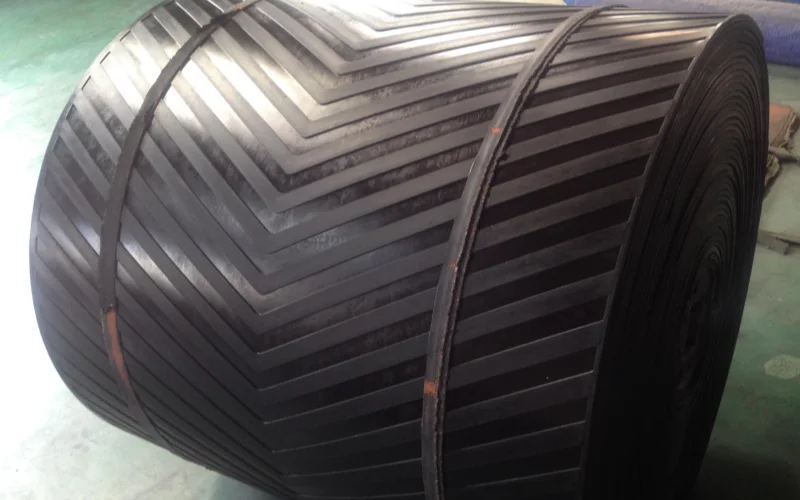
6. UT Type Patterned
Squared cleats hold compacted, dense loads with minimal bounce. Great for fly ash or calcined stone.
| BeltWidth (mm) | Chevron Width (mm) | Spacing between patterns (mm) | widthof thebelt edge (mm) | Chevron height (mm) | DW(mm) | EW(mm) |
| 800~1350 | 750 | 175 | 0~550 | 25 | 15 | 25 |

7. HY Patterned
Extended Y structure for irregular chunks: tire scrap, wire bundles, or mixed refuse.
| BeltWidth (mm) | Chevron Width (mm) | Spacing between patterns (mm) | widthof thebelt edge (mm) | Chevron Height (mm) | DW(mm) | EW(mm) |
| 400~700 | 425 | 250 | 0~300 | 15 | 10 | 15 |

8. UY Patterned
Combines volume holding and directional control—handles feedstock with variable moisture and mass.
| BeltWidth (mm) | Chevron Width (mm) | Spacing between patterns (mm) | widthof thebelt edge (mm) | Chevron Height (mm) | DW(mm) | EW(mm) | Widthof mold |
| 500-650 | 430 | 330 | 30 | 17 | 10 | 17 | 650 |
| 650-800 | 640 | 330 | 30 | 17 | 15 | 17 | 800 |
| 800-1400 | 800 | 330 | 30 | 17 | 1400 |

9. Multi-V Pattern
Tight, repeating Vs for fast throughput of small particles. Controls granule drift at high belt speed.
| BeltWidth (mm) | Chevron Width (mm) | Spacing between patterns (mm) | widthof thebelt edge (mm) | Chevron Height (mm) | DW(mm) | COLUMN | mold1 |
| 500-1600 | 1550 | 65 | 0~25 | 6 | 8 | 10 | |
| 500-1400 | 1360 | 65 | 5 | 8 | 10 | mold2 |

10. Connected V Pattern
Continuous chevron wall to contain wet or rolling materials. Maintains form at high angles.
| BeltWidth (mm) | Chevron Width (mm) | Spacing between patterns (mm) | widthof thebelt edge (mm) | Chevron Height (mm) | VWidth | lengthof mold (mm) | mold1 |
| 500-1350 | 1350 | 17 | 0 | 2 | 55 | 2300 | |
| 500-1300 | 1300 | 18 | 0 | 3 | 2300 | mold2 |

11. Dotted Pattern
Low-profile dots for packaging or soft goods. Common in parcel, carton, and bag handling.
| BeltWidth (mm) | Chevron Width (mm) | Spacing between patterns (mm) | widthof thebelt edge (mm) | Chevron Height (mm) | DW(mm) | Width | mold1 |
| 600-850 | 590 | 50 | 190 | 8 | 30 | ||
| 690-900 | 690 | 18 | 0 | 3.5 | 22 | mold2 | |
| 690-700 | 690 | 80 | 0 | 5 | mold3 |

12. “一” Pattern
Simple horizontal bars across belt width. Offers light resistance to slipping packages.
| BeltWidth (mm) | Chevron Width (mm) | Spacing between patterns (mm) | widthof thebelt edge (mm) | Chevron Height (mm) | DW(mm) | Widthof mold (mm) | mold1 |
| 400-700 | 700 | 400 | 0 | 15 | 800 | ||
| 500-800 | 475 | 330 | 0-162 | 30 | 900 | mold2 | |
| 550-900 | 530 | 753 | 0-140 | 45 | 18 | 1000 | mold3 |
| 1000 | 1000 | 0 | 10 | 1000 | mold4 |

13. Diagonal Pattern
Redirects flow diagonally. Used for alignment of side-feed or offset chute material.
| BeltWidth (mm) | Chevron width (mm) | Spacing between patterns (mm) | widthof thebelt edge (mm) | Chevron Height (mm) | DW(mm) | Widthof mold (mm) |
| 800 | 830 | 55 | 0 | 9 | 10 | 910 |

14. Cross-Patterned
Interlaced grid for fiber-rich loads like bagasse or shredded fabric. Slows down flow gently.
| BeltWidth (mm) | Chevron Width (mm) | Spacing between patterns (mm) | widthof thebelt edge (mm) | Chevron Height (mm) | DW(mm) | Widthof mold (mm) |
| 650-700 | 650 | 250 | 0-50 | 13 | 10 | 800 |

15. Diamond Pattern
Flat-faced diamond units reduce sticking while maintaining grip. Excellent for moist construction materials.
| BeltWidth (mm) | Chevron Width (mm) | Spacing between patterns (mm) | widthof thebelt edge (mm) | Chevron Height (mm) | DW(mm) | Widthof mold (mm) | mold1 |
| 480 | 0-210 | 1000 | |||||
| 1000 | 0 | 1000 | mold2 |

16. Circular Pattern
Raised hemispheres offer balanced grip for sensitive loads. Widely used in electronics and food logistics.
| BeltWidth (mm) | Chevron Width (mm) | Spacing between patterns (mm) | widthof thebelt edge (mm) | Chevron Height (mm) | DW(mm) | Widthof mold (mm) |
| 500-1000 | 490 | 90 | 0-255 | 35 | 1100 |

2.2 Cleat Height Classification: Where 6mm Becomes a Turning Point—and Why You Can’t Ignore the Range
The cleat height on a chevron conveyor belt isn’t just about the slope—it directly influences belt rigidity, pulley diameter, energy usage, and maintenance downtime. At Tiantie Industrial, cleat heights range from 2mm all the way up to 45mm, with clearly defined behaviors in each range.
Let’s break it down:
2–6mm: Surface Control Range
These are low-profile cleats used mostly for parcel, food, or bag handling on inclines less than 15°.
Manufactured via simple compression vulcanization, they offer texture more than physical material retention.
6–8mm: Transition Zone
This is where cleats start behaving like structural components. Depending on cleat shape, belts here may require mold inserts or segmental tooling.
At 6mm+, the belt begins to actively resist rollback. It marks the start of true incline transport functionality.
In later sections, we’ll explore why belts above 6mm often require custom splicing molds and what happens when maintenance skips those requirements.
8–10mm: Flex-Stress Balancing Zone
This range walks a fine line between grip and flexibility. A 9mm cleat must withstand tension but also pass through narrow return paths.
It’s especially popular in warehouse lines, agri-loaders, and compact conveyor systems where pulleys are smaller.
10–20mm: Industrial Standard Zone
This is the core of bulk material transport. Mining, cement, grain, and aggregate operations rely on cleats in this range for slopes between 18° and 30°.
Most belts in this class are multi-ply, and require pulleys with ceramic lagging and scraper support.
20–25mm: Intermediate Heavy-Duty
Used where fine-to-medium bulk materials behave inconsistently. Think coal mixed with moisture, or raw ore with clay.
These belts require reinforced cleat base design and often operate under variable feed pressure.
25–35mm: Heavy-Duty Bulk Handling
Capable of slopes beyond 35°, this range includes most mining-grade belts. Material rollback becomes a structural problem at this height.
Expect frequent edge tracking adjustments and stronger end supports.
35–40mm: Aggressive Incline Systems
Built for when incline becomes near-vertical. Sticky, wet, or layered materials need extra-tall cleats to prevent backward flow.
At this range, belts require high-temp bonding, custom cleaning heads, and load balancing idlers.
40–45mm: System-Specific Extremes
These aren’t standard belts—they’re components of engineered systems. Used in quarries, ports, or mining shafts where there’s no room for horizontal runs.
Each cleat is essentially a shovel blade. Splicing, tension, and frame specs must all be tailored.
2.3 Belt Width & Structural Interaction: Why Wider Isn’t Always Better
In the world of conveyor engineering, it’s tempting to believe that increasing the belt width will solve capacity problems. After all, a wider chevron conveyor belt should carry more material per minute, right?
But in practice, increasing width introduces nonlinear complications—especially when cleat geometry, incline angle, and load behavior aren’t considered in tandem.
Tiantie Industrial manufactures chevron conveyor belts in widths from 300mm to 2400mm, but each category comes with its own structural consequences.
300mm–600mm Belts: Compact, Mobile Applications
This range is commonly used in agriculture, light packaging lines, and mobile field conveyors. Because of the smaller footprint and lighter loads, these belts often use cleats under 8mm, with open or multi-V patterns.
The challenges here revolve around flexibility and motor power efficiency. A belt that’s too rigid at this width can cause over-tensioning and edge curling, especially if cleats are oversized relative to belt thickness.

800mm–1400mm Belts: Industrial Midrange
This is the sweet spot for many industries—mining, grain terminals, cement plants. These belts carry real tonnage and often include cleat heights between 10mm and 25mm, with patterns selected based on flow consistency and rollback risk.
At these widths, pulley lagging, scraper installation, and return roller design become essential. An improperly aligned scraper can prematurely wear cleats. A belt this size requires uniform feed distribution, or you risk tracking drift and uneven cleat fatigue.

1600mm–2400mm Belts: Heavy-Duty Custom Systems
Here, the chevron conveyor belt becomes part of a larger material handling architecture. These belts support tall cleats (30–45mm) for inclines of 30–40°, often in outdoor or high-moisture operations.
Wider belts amplify every small error. A 5mm misalignment at the tail pulley can result in edge wear or cleat base separation within weeks. Belt sag between rollers increases exponentially with width, which is why these systems often use closely spaced idlers, tension sensors, and automatic centering units.

It’s not just the cleat that needs to be reinforced—it’s the entire supporting system.
2.4 Power Efficiency, Tension, and Real-World Impacts
The energy profile of a chevron conveyor belt is one of the most overlooked cost variables in long-term system operation. While cleats reduce rollback and improve material control, they also introduce new considerations in friction, belt flexing, and start-up torque.
Reduced Tension, But Increased Form Drag
Unlike flat belts that rely entirely on tension and friction for grip, a chevron conveyor belt gets most of its uphill holding power from the cleats themselves. This means overall belt tension can be lower—but cleats create resistance during pulley engagement, especially on smaller drums.
If cleat height exceeds 25mm, pulley diameters must increase to prevent cleat distortion and surface peeling. Smaller pulleys cause cleats to compress at odd angles, which accelerates wear and increases motor resistance during startup.
Motor Load Behavior in Real Systems
In field conditions, belts with tall cleats often show surges in power draw during acceleration—especially when loaded while stationary. That’s because cleats have to engage both the material and the drive force at once.
To minimize these spikes, Tiantie often recommends:
- Pulley ceramic lagging for better traction
- Pre-tensioning at 75% of nominal belt strength
- Start-up delays after loading to allow belt to stretch and settle
- Installation of soft-start VFDs (variable frequency drives) on long incline runs
Done correctly, systems using chevron conveyor belts can run at 8–12% lower average energy consumption compared to over-tensioned flat belts—even with cleat resistance taken into account.
Return Path Design & Cleat Management
What goes up must come down—and cleats don’t just disappear on the return side. On a chevron conveyor belt, raised cleats don’t flatten on the return like a flat belt. They must be physically accommodated or managed.
That means:
- Return rollers must be spaced to prevent cleat contact
- Spring-loaded hold-down rollers or U-shaped trough rollers may be required
- In some systems, backside belt scrapers are used to remove material stuck to cleats
- For belts with cleats ≥30mm, some systems add guide tracks to stabilize belt position and avoid cleat drift under weight
Ignoring this part of the design is a recipe for early belt failure. One overloaded return roller and your cleats start to tear—a slow death that shows up as efficiency loss before it ever becomes visible damage.
Material Behavior Changes Everything
Even the most technically correct chevron conveyor belt will fail if it doesn’t match the material’s personality. That’s why Tiantie engineers often request samples or run simulations—not because specs aren’t enough, but because real-world materials don’t behave like they do on datasheets.
Moist limestone sludges may need closed V cleats at 30mm. Dry maize kernels may need U-type at just 12mm. The wrong match means:
- Material sticks between cleats
- Cleats wear unevenly
- The belt draws more power but moves less volume
Chevron conveyor belts must be treated as engineered products, not catalog parts.

Get Our Top Sales Pattern
Contact us now to get the top-selling chevron conveyor belt pattern list.
3. Inclination Angle & Material Matching
Selecting the right chevron conveyor belt for an inclined system isn’t just about picking a cleat and a width. The real challenge lies in managing how different materials behave when gravity pushes against your design. Incline angle and material characteristics don’t operate independently—they interact, often in ways that aren’t obvious until production stops or belts wear prematurely.
3.1 Understanding Material Behavior vs. Inclination: Don’t Trust the Lab Numbers Alone
Most material data sheets list an “angle of repose,” but anyone who’s operated real-world conveyors knows that static repose and live flow are two different animals. The angle at which a pile of fertilizer sits in a warehouse doesn’t tell you how it behaves on a 30° incline in humid conditions at 1.2m/s belt speed.
Here’s what actually matters:
- Bulk density affects cleat penetration. Light materials don’t settle between cleats easily, especially if airflow or vibration is present.
- Moisture content changes everything. Dry coal might run smoothly on a 28° incline with U-pattern cleats. Add moisture and it turns to sludge, needing a different cleat entirely.
- Granular size determines the ideal cleat gap. Too narrow and you get jamming. Too wide and rollback increases.
If you treat “material + incline” as a single equation, you’re already a step ahead of most procurement decisions.
3.2 Aligning Cleat Architecture with Real-World Incline Forces
Chevron profiles are not one-size-fits-all. The same 25mm Closed V cleat that works for damp sand at 26° might cause spillage if used with dry grain at 18°. Successful belt selection means matching:
- Incline force
- Material stability under motion
- Cleat height + spacing + stiffness
Here’s what you should look for:
- For angles above 30°, use cleats above 25mm with wide, structured profiles—Connected V or HY patterns work well for cohesive or sticky materials.
- At 20–30°, most standard profiles work—Y, Closed V, or UT—but only if cleat spacing matches your material’s flow rate. Faster belts = wider spacing.
- Under 15°, cleats serve more to center or guide the load than to resist rollback. Low-profile patterns like “一” or Dotted are more efficient and easier to clean.
One mistake often made: assuming a more aggressive cleat always improves performance. In fact, over-cleating can reduce flow consistency, especially for dry granular materials that bounce between rows. Always evaluate belt speed vs. cleat rhythm.

3.3 When Not to Use a Chevron Conveyor Belt—And What to Use Instead
Despite its versatility, there are certain cases where a chevron conveyor belt is either inefficient or entirely unsuitable. The fix isn’t to force a cleated solution—it’s to switch to a structure better aligned with your material and process.
Let’s break it down by failure mechanism:
❌ Scenario 1: Fine Particulates + Humidity = Progressive Cleat Clogging
In industries like cement, fly ash, or fertilizers with hygroscopic properties, fine particles tend to stick inside cleat valleys and accumulate layer by layer. Once buildup begins, flow rate drops and maintenance costs rise.
Recommended Alternative:
Skirted flat belt with controlled feed rate
Why: Smooth surface avoids material trapping, and skirts contain side spillage. Combine with metering screw or belt feeder to regulate flow on incline ≤18°.
❌ Scenario 2: Systems Requiring Bidirectional Operation
Most chevron profiles are directional by nature. Reversing the belt causes cleats to act against the material, resulting in spillage, jamming, or cleat damage.
Recommended Alternative:
Flat belt + modular guides, or
Modular plastic chain with two-way cleat structure
Why: Flat belts support symmetrical flow, and modular chains with bidirectional paddles allow full reverse operation without buildup risk.
❌ Scenario 3: Washdown, Hygienic, or Food-Grade Environments
Raised cleats are difficult to sanitize and may trap particles or fluids. In food and pharma, this can violate HACCP or FDA standards.
Recommended Alternative:
Monolithic PU flat belts with minimal profile
Open-hinge modular plastic belts
Why: Flat belts are easy to CIP (Clean-in-Place); modular belts can be disassembled for high-pressure cleaning. Use in inclines ≤12°.
❌ Scenario 4: Irregular Shaped or Impact-Heavy Loading
In recycling or waste systems, materials like crushed glass, metal scraps, or twisted rebar can catch on cleats and damage them during loading. Chevron profiles wear unevenly and fail prematurely.
Recommended Alternative:
Flat belt with steel-reinforced cleats or
Bucket elevators / apron conveyors for steep inclines
Why: Steel inserts resist tearing, and paddled systems allow positive material retention without relying on cleat friction.

Each of these alternatives is not just a workaround—they’re optimized responses to real operational constraints. Choosing a chevron conveyor belt should never be a default decision. It should be a technical one.
4. Design & Dimensions of Chevron Conveyor Belts
4.1 Pattern Geometry: Not Just Raised Rubber, but Load Management Tools
The surface design of a chevron conveyor belt is a functional system, not decoration. Every angle, height, and alignment of the pattern contributes to material control under slope, moisture, and vibration.
- Pattern angle determines how material engages with the belt surface. Open geometries promote forward flow, while tight or enclosed formations provide resistance against rollback.
- Height of the raised structure defines how much grip is exerted. Profiles below 10mm offer directional guidance; those above 25mm serve as material containment structures.
- Symmetry affects how evenly weight is distributed across the belt width. Symmetrical patterns prevent tracking drift, while asymmetrical ones help center erratic loads—but only if your loading point is precise.
The wrong geometry causes inconsistent flow, overloading at transitions, or premature belt edge wear.
4.1.1 Drive System Compatibility: Geometry Must Match Power Transfer
A well-shaped surface pattern becomes a liability when it isn’t aligned with the drive configuration. On higher incline belts—especially those using raised profiles beyond 20mm—the contact between belt and pulley must be carefully engineered.
- Too narrow a pulley diameter may compress pattern peaks, leading to premature deformation or partial contact. This reduces torque transmission efficiency.
- Drive wrap angle becomes critical. If the pulley only touches one half of a raised pattern, belt slip or bounce occurs. Installing pressure rollers or crowned pulleys helps maintain consistent grip.
- Unbalanced surface geometry—such as inconsistent V alignment—can cause lateral force misdistribution. The result is tracking drift or frame vibration.
For applications with sharp transitions or short-pitch patterns, it’s often necessary to increase the belt’s rigidity in both longitudinal and transverse directions to prevent distortion when moving over pulleys.
4.2 Material Composition: The Belt Surface Is Just the Beginning
A chevron conveyor belt must do more than resist wear—it must hold its mechanical shape under thermal, chemical, and tensile stress. Tiantie Industrial offers multiple surface and carcass combinations based on operational demands:
- Standard abrasion-resistant rubber (DIN Y or Grade M) handles stone, gravel, and dry aggregate.
- Oil-resistant rubber (MOR or DIN G) is essential for fertilizers, feed, or wood chips.
- Heat-resistant compound (T1/T2 up to 200°C) is used for clinker or hot foundry sand.
- Flame-retardant rubber meets ISO 340 / DIN K for enclosed plants or underground sites.
Chemical compatibility must also match your cleaning procedure. For example, using citrus-based degreasers on polyurethane layers may cause delamination over time.
4.3 Belt Structure: How Inner Layers Carry Outer Patterns
Patterned belts must flex, stretch, and hold their shape—all while resisting stress from the raised surfaces they carry. That makes the internal belt structure just as critical as the outer profile.
- Single-ply fabrics provide excellent flexibility and are best paired with patterns below 8mm.
- Multi-ply designs(3–5 layers) add longitudinal strength, suitable for most incline systems with profiles in the 10–25mm range.
- Cross-stiffened belts include transverse rigid layers that stabilize tracking on wide or fast-running systems.
- Steel-cord reinforced belts are essential when raised patterns exceed 30mm or belt widths surpass 1600mm, especially under heavy load and sharp incline.
Layer count and fabric orientation also influence pulley diameter. More rigid belts demand larger drive drums to prevent folding or surface cracking near the pattern base.
4.4 Dimensional Scope & Custom Engineering
Chevron conveyor belts from Tiantie Industrial are available in widths from 300mm to 2400mm, with standard and custom mold options. Profile height spans 2mm to 45mm, but once patterns exceed 25mm, the manufacturing process shifts to high-pressure, multi-segment molds with insert control.
- Cut-edge configurations suit indoor or enclosed systems.
- Molded-edge belts offer better sealing and edge integrity for outdoor, wet, or abrasive environments.
- Edge tracking guides, embedded markers, or sensor lines can be added for smart belt applications.
Belt length is usually determined by the cleat pattern’s pitch. The total loop must sync with the pattern interval to avoid sudden discharge inconsistencies or product pile-ups at the head pulley.
5. Application & Practical Use of Chevron Conveyor Belts
5.1 Industries That Rely on Patterned Conveyor Design
The chevron conveyor belt isn’t a niche product—it’s the backbone of material flow in dozens of demanding industries where slope, moisture, and irregular materials are everyday challenges. What connects them isn’t the industry, but the material behavior.
In mining, inclined belts transport coal, ore, and tailings up from pits or underground levels to processing plants. These materials are often moist, abrasive, and heavy. Without patterned belts, rollback and inconsistent feed are daily risks.
In agriculture, grain elevators, seed handlers, and mobile harvesters often require compact conveyors with high grip but minimal residue buildup. Chevron patterns prevent backslide without damaging delicate crops.
In recycling facilities, shredded plastic, crushed glass, or metal scrap won’t stay on flat belts. The raised profiles of chevron designs stabilize loads—even when the flow is unpredictable or when operators stop-start multiple times per minute.
Construction and cement plants use chevron conveyor belts to move fine sand, wet concrete mix, or fly ash across steep incline systems. Standard belts fail quickly under such abrasive, heavy loads. Patterned belts survive longer and perform more consistently when matched to the right incline and material flow rate.

5.2 Real-World Performance Gains
One of the biggest advantages of the chevron conveyor belt is its ability to reduce slippage while maintaining throughput on inclines that would otherwise require bucket elevators or complicated material lifts.
When properly selected:
- Throughput increases by 15–30%versus flat belts on inclines >20°
- Energy savings of 8–12%are achieved by reducing the need for high belt tension
- Maintenance cycles extend due to even surface wear across raised profiles
But this only happens when the pattern height, spacing, and orientation match both the material and the system layout. A belt that works perfectly for soybeans in Argentina might completely fail on wet phosphate rock in Morocco—unless the surface geometry is correctly specified.
5.3 When Patterned Belts Fail—and What to Learn from It
Chevron patterns are effective, but not immune to misapplication. Certain systems push them outside their functional design envelope.
- In one Middle Eastern fertilizer terminal, a patterned belt installed in a bidirectional reclaim system caused severe buildup on the return path—because the pattern was never meant to operate in reverse. It eventually jammed the head pulley and delaminated after four weeks.
- In Southeast Asia, a mining belt using ultra-high chevron profiles for wet sand faced accelerated wear—not because the pattern was wrong, but because the belt body lacked the reinforcement needed to support the taller surface under load impact.
The takeaway isn’t that patterned belts fail—it’s that they must be applied as systems, not parts. Belt surface design, carcass structure, drive configuration, and cleaning strategy all work together.

Chevron conveyor belts are powerful tools when selected with precision. Across industries, they solve the same fundamental problem: moving materials uphill without letting gravity win. But when treated as generic products instead of engineered components, even the best-designed profile can become the weak point in the system.
6. Cost & Supply Chain Considerations for Chevron Conveyor Belts
When evaluating the true cost of a chevron conveyor belt, you’re not just paying for a roll of rubber—you’re paying for controlled chemistry, molded geometry, time-intensive processing, and a globally sensitive raw material chain. The deeper you understand what goes into the belt, the better you’ll understand why prices fluctuate—and how to compare options wisely.
6.1 What Actually Affects the Price of a Chevron Conveyor Belt?
1. Rubber Compound Type and Performance Grade
Most reputable manufacturers start with natural rubber as the base polymer, then enhance it with carbon black, sulfur, accelerators, and plasticizers through internal mixing (banbury or kneader). What’s rarely discussed is that natural rubber is a commodity on the global futures market. When international rubber prices surge, especially due to oil prices or Southeast Asian climate events, the price of raw compound increases. And since rubber compounding accounts for a major portion of manufacturing cost, that increase cascades into finished product pricing.
More specialized formulas—like oil-resistant, heat-resistant (up to 200°C), or flame-retardant rubber—use additional chemical modifiers that further raise the cost.
If a quote seems unusually cheap, chances are the belt was made using recycled filler, calcium-based diluents, or lower-purity stock. These may pass initial QC but fail under dynamic loads or thermal cycles within months.

2. Pattern Height and Complexity — And the Real Meaning of 6mm
As discussed earlier, 6mm is the critical dividing line—not because of the size itself, but because of how the pattern is manufactured.
✅ Below 6mm: Integrated Mold Vulcanization (One molding)
For chevron patterns 6mm and under, the pattern is formed during the vulcanization of the rubber belt itself. No extra rubber strips are applied. Instead, a mold with recessed pattern grooves is pressed directly onto the uncured belt, and the pressure from the vulcanizing press itself forms the raised shape.
This method is:
- Fast
- Requires no post-alignment
- Lower cost due to short cycle times and reduced labor input
However, it only works for low-profile patterns with minimal depth and no complex structural ribs.

✅ Above 6mm: Segmented Mold + Bonded Vulcanization (Separated mold + rubber strip bonding vulcanization)
Once pattern height crosses the 6mm threshold, manufacturers must shift to a multi-step process:
1.Pre-mixed rubber strips are cut and prepared.
2.These strips are placed into a mold with negative pattern impressions.
3.The flat rubber conveyor belt is aligned with the mold.
4.Under high pressure and heat, the strips vulcanize and bond permanently to the belt surface.
This is not gluing—it’s chemical bonding through molecular cross-linking. However, it requires:
- Longer vulcanization time
- Greater pressure (due to insert thickness)
- Manual alignment of strips within the mold
- Temperature control to avoid partial curing
As a result, belts with patterns above 6mm can cost 30–70% more due to tooling, labor, and production time—even when using the same compound.
Pattern complexity matters too. Open V patterns are simpler and cheaper. Patterns like Connected V, Multi-V, or Circular require more mold pieces and longer finishing time, especially when profile spacing must sync precisely over the belt length.

3. Width, Length & Pattern Synchronization
Chevron conveyor belts are available in widths from 300mm to 2400mm, but price doesn’t scale linearly with width.
Wider belts:
- Require custom mold beds
- Need even pressure distribution during vulcanization
- Require longer curing time due to heat gradient control
For long belts (over 50 meters), pattern synchronization becomes a cost-driving factor. That means the belt length must be carefully adjusted to ensure no pattern misalignment at the spliced joint or head pulley. Precision cutting, alignment, and sometimes customized mold pitch matching is required.
4. Belt Carcass Construction and Reinforcement Layers
A belt with tall patterns sitting on a weak carcass is like building a skyscraper on a dirt foundation. The belt’s internal structure must match the mechanical demands imposed by the surface geometry and material load.
- 2-ply EP: economical but limited to light-duty applications and low-profile patterns
- 3–5 ply EP: standard for most medium-duty chevron conveyor belts
- Steel-reinforced: required when pattern height exceeds 25–30mm or when belt width exceeds 1600mm
Adding cross-stabilizing layers increases rigidity and tracking stability—but also adds thickness, weight, and cost. Always request the carcass spec sheet—not just the surface compound—before comparing quotes.
5. Special Features, Splicing Costs, and Customization Options
Here’s where many buyers get blindsided. Some of the biggest hidden costs come from the final 10% of the belt:
✅ Hot Vulcanized Splices:
The chevron conveyor belt requires more than just a straight-line joint. Each pattern must align exactly at the splice, and the internal fabric layers must bond without displacement. The splicing mold must accommodate the pattern geometry, which increases tooling costs and labor time.
Expect to pay 30–50% more for a spliced patterned belt vs. a flat belt of the same width and carcass spec.
✅ Molded Edge or Cut Edge?
Molded edges improve weather resistance and are ideal for outdoor or damp environments. Cut-edge belts are easier to handle in tight installations but may fray under high humidity or edge loading.
✅ Custom alignment, tracking guides, batch ID stamping, or rubber back splices all increase cost slightly—but can make or break performance in automated or high-load systems.

6.2 Choosing a Supplier: What Actually Matters
Choosing a supplier for a chevron conveyor belt isn’t about flashy catalogs—it’s about engineering capability and production consistency.
✅ Evaluate them on:
- Range of mold sizes (Can they handle both <6mm and >30mm profiles?)
- Precision in pitch alignment and pattern repeatability
- Willingness to provide rubber compound formulation specs or batch reports
- History with complex splicing requests
- Support for high-MOQ widths like 2000mm+ or long custom runs
If a supplier can’t explain how they control pattern bonding or why their belt costs more above 6mm pattern height—they’re not offering a system solution, just a shaped product.
7. Installation & Maintenance of Chevron Conveyor Belts
Installing a chevron conveyor belt isn’t just about bolting it into place and pressing “Start.” Unlike flat belts, the raised profile adds new layers of complexity—literally and mechanically. From tensioning and splicing to cleaning and return tracking, every step requires more precision, and ignoring those details can turn a $1,000 belt into a $10,000 maintenance nightmare.
7.1 Tensioning, Tracking, and Initial Setup
The raised surface of a chevron conveyor belt increases its rigidity, especially with higher pattern heights and multi-ply constructions. This means:
- Tensioning requires higher initial force to eliminate slack, but overtensioning risks delamination of the pattern from the belt base (especially above 20mm height).
- A good rule of thumb: Start with 110% of the tension used for a flat belt of the same carcass spec, then reduce incrementally as the belt warms during operation.
- Use hydraulic or screw-type take-ups that allow fine adjustment without sudden jolts.
Tracking becomes especially tricky with asymmetrical or offset patterns. The belt’s natural center of mass may no longer align with its geometric center. To mitigate drift:
- Install center-guided rollers near both the head and tail pulleys.
- Use guide rings or edge limiters on the return side.
- Make sure the frame is aligned within ±0.5 mm across the belt width—this is no place for a welding guess.
7.1.1 Splicing Chevron Conveyor Belts: Why It’s a Whole Different Game
Flat belts are hard enough to splice well. But a chevron conveyor belt adds one massive complication: the pattern must match perfectly across the splice line.
In hot vulcanized joints, here’s what makes it so tricky:
- Pattern alignment: If the V-shapes don’t line up, material will bounce or pile at the joint. Worse, the joint becomes a weak spot for delamination.
- Fabric layer offset: Unlike flat belts, chevron belts must have fabric plies precisely staggered to ensure strength without interrupting the pattern mold’s pressure.
- Molded tooling: Specialized vulcanizing molds with cavity inserts are needed to continue the pattern seamlessly across the joint.
- Pressure control: Inconsistent press force leads to undercured pattern tips or hard spots in the fabric joint.
These variables mean splicing a chevron conveyor belt can take 2× longer and cost 40–60% more than a typical flat belt joint. Cutting corners is not just bad—it’s dangerous.
7.2 Daily and Scheduled Maintenance Priorities
Once installed, patterned belts require stricter maintenance protocols to prevent downtime or premature wear.
Key areas to monitor:
1.Pattern wear: Look for uneven height loss on one side—it may signal a frame misalignment or off-center loading.
2.Joint fatigue: Inspect splice lines for cracks, peeling edges, or pattern discontinuity.
3.Edge fray: A classic sign of incorrect tracking or return path obstruction.
4.Return side buildup: Pattern ridges tend to trap fines or wet material on the bottom run.
Best practices:
- Perform visual inspections every 100 operating hours
- Use thermal scanners on splice joints to detect internal tension shifts
- Replace worn return rollers before they grind into pattern tips
- Keep a log of tracking adjustments to trace long-term drift trends
7.3 Cleaning Chevron Conveyor Belts the Right Way
Here’s where many operators get frustrated. Standard flat-blade scrapers don’t work on a chevron conveyor belt—they ride over the ridges and miss the valleys completely.
Instead, use one or more of the following:
- Rotating brushes: Ideal for sticky materials like wet sand or clay
- Curved polyurethane scrapers: Designed to flex into pattern grooves without cutting
- Segmented belt cleaners: Allow for independent adjustment to match chevron valleys
Don’t forget the return side. Patterned belts create more opportunity for material fallback. To prevent buildup or tracking issues:
- Install spring-loaded return rollers
- Use back-pressure hold-down wheels
- Consider a belt flap to limit loose fines from falling off at the tail
Bonus Tip: Avoid the “Reverse Surprise”
Chevron patterns are directional by nature. Reversing the belt—intentionally or due to motor fault—can cause:
- Material pile-up at the head
- Ridge separation from belt base
- Splice stress from backward shear
If bidirectional use is unavoidable, a flat belt with sidewalls or cross-cleats may be more appropriate.

8. Structural Design Pitfalls and Functional Optimization for Chevron Conveyor Belts
Despite their unmatched performance on inclined conveyors, chevron conveyor belts come with structural challenges that flat belts simply don’t face. Their added thickness, stiffness, and surface geometry require careful system adaptation—from the drive unit to the idler arrangement. Ignoring these structural details often leads to premature belt failure, unstable tracking, and costly shutdowns.
This section addresses three critical areas where engineering design must meet operational reality.
8.1 Drive System Coordination with Starting Inertia
A chevron conveyor belt typically weighs more and is less flexible than a flat belt of the same width and length. The raised surface patterns, especially those exceeding 12mm in height, increase the mass per meter and the belt’s resistance to bending. When the drive system isn’t adjusted accordingly, several issues can occur during startup:
- Excessive torque demand on the motor
- Belt slippage on the drive pulley
- Irregular acceleration, causing false belt misalignment signals
- Localized stress near the splice or along the pattern base
These problems stem from the system underestimating the belt’s startup inertia.
✔ Engineering Recommendations:
- Increase the pulley wrap angle.This can be achieved by adding a snub pulley before or after the drive pulley to provide more surface contact, especially necessary when handling steep inclines or high-tension belts.
- Install pressure rollers above the drive pulley.These hold-down rollers ensure that even thick patterns remain fully engaged with the pulley face, especially for profile heights above 15–20mm.
- Use ceramic lagging on the drive pulley.When dealing with wet or dusty materials, standard rubber lagging quickly loses friction. Ceramic lagging improves grip and reduces the chance of belt slippage under load.
- Opt for hydraulic tensioning systems.Compared to traditional screw take-ups, hydraulic tensioners adapt to dynamic belt movement, maintaining consistent pressure as the belt stretches or the load changes.
In short: designing a flat-belt drive for a chevron application is a shortcut to repeated failure. Addressing inertia with proper mechanical compensation is non-negotiable.
8.2 Diagnosing Misalignment, Belt Drift, and Edge Damage
Belt drift is a common issue in any conveying system, but for chevron conveyor belts, the consequences escalate faster. The stiffness of the patterned surface, combined with its tendency to steer under tension imbalances, often leads to:
- One-side edge wear or fraying
- Abrasion against frame components
- Belt “jumping” at impact or transition points
- Longitudinal strain at the joint caused by asymmetric load paths
These effects rarely come from a single cause. Rather, they are triggered by small mechanical inconsistencies that, over time, distort the belt’s centerline and tracking path.
✔ Root Causes and Solutions:
- Asymmetrical loading:Verify material loading is geometrically centered using chute indicators or flow modeling.
- Tension mismatch:Belts tensioned unevenly across the width can wander toward the lower-tension side. Use calibrated tensioning systems and verify regularly.
- Improper idler alignment:A difference of just 2mm between opposing idlers is enough to misdirect the belt. Alignment should be checked with laser or string line tools during installation and inspection.
✔ Practical Countermeasures:
- Install self-aligning troughing idlers at key positions, particularly before and after transitions.
- Add guide rollers or edge limiters near head and tail pulleys to restrict sideward drift.
- Use tracking sensors with auto-stop logic to halt the system before damage escalates.
- Keep a preventive log of tracking adjustments—if you’re adjusting more than twice a month, the root issue remains unsolved.
With chevron conveyor belts, minor tracking problems can rapidly lead to major damage. System symmetry and load stability are not optional—they’re structural requirements.
8.3 Chevron-Specific Idler Design: Why Standard Rollers Fail
One of the most overlooked sources of belt failure is roller mismatch. While standard three-part troughing idlers work well for flat belts, they often perform poorly when paired with patterned belts, particularly those with tall or complex profiles.
The result?
- The belt rides on the pattern tips instead of the carcass
- Return-side rollers compress the raised rubber unevenly
- Viscous particles tend to lodge between the raised patterns and the roller contours, increasing compression wear
- Return jamming and edge deformation become recurring problems
These outcomes reduce belt life significantly and often result in unexpected shutdowns.
✔ Optimized Roller Structures for Chevron Belts:
- Double horizontal return rollers:These distribute belt weight across the flat carcass area, avoiding pressure points on raised profiles and minimizing deformation during the return path.
- U-shaped central support rollers:Ideal for applications where material distribution varies across the belt width. The design supports the central portion of the belt while allowing raised patterns to hang freely without interference.
- Anti-interference idler brackets:In systems with tall, spaced, or asymmetric patterns (e.g., UY, HY, Multi-V), these brackets hold the belt in a way that eliminates pattern contact with the idler frame, reducing material accumulation and belt distortion.
- Reduced-pitch impact idlers:For belts operating in high-impact zones, shortened idler spacing can mitigate bounce and prevent the pattern from digging into the idler surface.
Applying standard idlers to chevron belts is like fitting snow tires to a racing bike—technically possible, but practically disastrous. The belt must be supported in a way that respects its geometry.

9. Frequently Asked Questions about Chevron Conveyor Belts
Q1: What makes a chevron conveyor belt different from a flat conveyor belt?
At a glance, the difference is obvious—chevron conveyor belts have raised patterns, while flat belts don’t. But the difference goes much deeper than surface texture.
Chevron belts are designed for steep-angle conveying—often between 18° and 40°—and prevent rollback of loose or granular materials. The V-, U-, or Y-shaped patterns act like friction guides, holding the material in place as it climbs. Flat belts, on the other hand, struggle beyond 15–20° inclines without additional components like cleats or sidewalls.
Also, structurally speaking, chevron belts have greater surface stiffness, increased mass per meter, and often require custom drive and idler configurations. They’re not just flat belts with some rubber glued on top—they’re engineered for uphill work.
Q2: Can I use a chevron conveyor belt for bidirectional or reversible conveying?
In general, no. A chevron conveyor belt is a one-way street. The raised pattern is designed to grip material in one direction. If you run the belt in reverse, several things can go wrong:
- Material gets trapped behind the pattern and builds up
- Belt alignment becomes unstable due to uneven surface drag
- Patterns begin to peel or tear due to unintended shear forces
If your application requires bidirectional operation, consider flat belts with cleats, modular chain belts, or sidewall belts with symmetrical profiles.
Q3: What incline angle is too steep—even for chevron belts?
That depends on the pattern height and type, as well as the material’s flow characteristics. In general:
- Low-profile chevron patterns (≤10mm) work best under 20°
- Mid-range profiles (12–25mm) can handle 25°–35°
- Heavy-duty patterns (30–45mm) may go up to 40°, depending on material properties
However, don’t push the limits without considering material rollback behavior. Free-flowing materials like soybeans or dry sand can be moved at steeper angles than damp clay or crushed ore.
When in doubt, always request a pattern-height-to-angle reference chart from your supplier—or better yet, test in your own setup.
Q4: Why is hot vulcanized splicing for chevron belts more expensive than for flat belts?
Because there’s more to it than just bonding two ends together. A good hot splice on a chevron conveyor belt must do three things at once:
1.Ensure proper rubber-to-rubber bonding across the internal plies
2.Maintain pattern continuity, so that the raised profile aligns seamlessly
3.Avoid creating hard spots or misaligned ridges, which can impact tracking or wear
This requires custom molds, controlled pressure and heat timing, and more labor-intensive prep. It’s not something a basic vulcanizing team can do correctly without experience.
Q5: What’s the longest chevron conveyor belt system in operation?
While long-distance conveying is more commonly done with flat belts, there are chevron systems used in modular incline segments within large installations. Some quarry and aggregate facilities in Southeast Asia and Africa use chevron belts in multi-stage incline systems that span over 300 meters in length—though not as a single continuous belt.
These systems use chevron belts where incline matters, then transition to flat belts for horizontal runs. It’s not about one belt doing everything—it’s about each section doing its job well.

